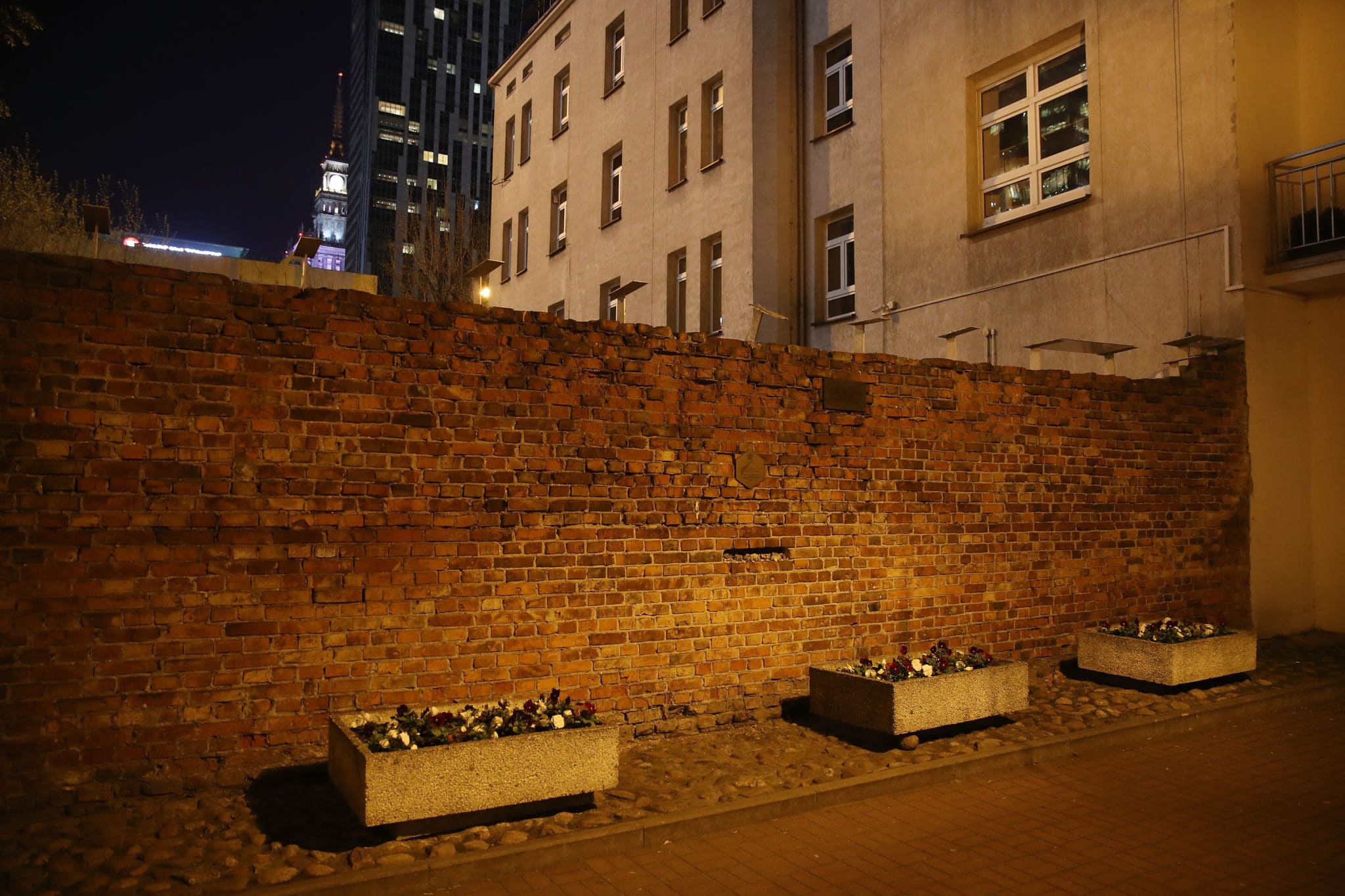 WARSAW, POLAND – APRIL 12: A surviving portion of the wall that once enclosed the former Warsaw Ghetto stands near Sienna Street on April 12, 2018 in Warsaw, Poland. Poland will commemorate the 75th anniversary of the Warsaw Ghetto Uprising on April 19. The Warsaw Ghetto was a prison created by the German military during its occupation of Warsaw during World War II. Starting in 1940, 400,000 Jews were confined to a walled-in neighborhood of 3.4 square kilometers under horrific conditions. With assistance from Polish partisans the Jews rose up in armed resistance in 1943 and held off the Germans for several weeks until the Germans annihilated the ghetto, killing 13,000 people. In all 392,000 Jews from the Warsaw ghetto were killed, most of them after deportation to the Treblinka death camp. (Photo by Sean Gallup/Getty Images)
WARSAW, POLAND – APRIL 12: A surviving portion of the wall that once enclosed the former Warsaw Ghetto stands near Sienna Street on April 12, 2018 in Warsaw, Poland. Poland will commemorate the 75th anniversary of the Warsaw Ghetto Uprising on April 19. The Warsaw Ghetto was a prison created by the German military during its occupation of Warsaw during World War II. Starting in 1940, 400,000 Jews were confined to a walled-in neighborhood of 3.4 square kilometers under horrific conditions. With assistance from Polish partisans the Jews rose up in armed resistance in 1943 and held off the Germans for several weeks until the Germans annihilated the ghetto, killing 13,000 people. In all 392,000 Jews from the Warsaw ghetto were killed, most of them after deportation to the Treblinka death camp. (Photo by Sean Gallup/Getty Images) A Sept. 2 report for National Public Radio (NPR) stated that how the Jews handled typhus in the Warsaw Ghetto served as an example of “how to beat back an outbreak.”
The report, titled “The Warsaw Ghetto Can Teach the World How to Beat Back an Outbreak,” said that two waves of typhus hit the ghetto in 1940 and 1941, resulting in an official total of 20,160 reported cases, although it is believed that the true figure was in the 80,000-110,000 range, if not higher.
The report then cites a study from Advance Sciences magazine in July stating that the waves of typhus subsided in October 1941, which initially puzzled the authors of the study because typhus tends to become more prevalent during the winter. The study concluded that Jews were able to defeat typhus in the ghetto through establishing their own classes on public hygiene and infectious diseases as well as inspections on buildings and apartments to ensure people were adhering to the community’s hygienic standards.
“There were also home-cleaning programs by self-governing bodies in the ghetto with the goal of eradicating typhus,” the NPR report stated. “In addition, an underground university was set up to train medical students, and scientific studies on the phenomenon of starvation and epidemics were conducted.”
Additionally, the study suggested that efforts to bring more food into the ghetto also may have played a role in eradicating typhus.
“The Nazis began seeing some ghetto residents as potential workers and increased food aid in the ghetto and briefly allowed food smugglers to bring in rations,” the NPR report stated. “In addition, community soup kitchens were set up and provided food for some 100,000 residents, funded with money smuggled into the ghetto by an American Jewish aid group, the Joint Distribution Committee, and coordinated by ghetto leaders.”
One historian, Trinity College professor Samuel Kassow, told NPR that he didn’t think social distancing measures played much of a role in defeating typhus in the ghetto because of overcrowding but he thinks that “a drive to improve sanitation in buildings may have played a role.” Two other researchers, Tel Aviv University professor Miriam Offer and Mount Sinai South Nassau (N.Y.) Hospital Chief of Infectious Diseases Aaron Glatt, speculated to NPR that herd immunity also could have been the reason why typhus disappeared in the ghetto in addition to the community’s public health measures.
“The level of desire and commitment to address a public health issue is the most important characteristic as to whether you will be successful,” Glatt, whose grandmother died in the ghetto and aunt died from typhus at Auschwitz, told NPR. “If you don’t take things seriously enough and don’t have the desire to beat it, people will die.”
Some on Twitter criticized NPR for using the Warsaw Ghetto as an example of how to defeat an epidemic.
“Do you know what kind of typhus and other diseases raged in that ghetto?!” former New York Democratic Assemblyman Dov Hikind tweeted. “Do you know people were forcefully confined to a few square blocks?!?! Nearly 100k Jews died there!! And that’s a good case study for ‘how to beat back an outbreak’?!”
Are you out of your freakin minds?!?!
Do you know what kind of typhus and other diseases raged in that ghetto?! Do you know people were forcefully confined to a few square blocks?!?! Nearly 100k Jews died there!!
And that’s a good case study for “how to beat back an outbreak”?! https://t.co/UAUwyDEidk
— Dov Hikind (@HikindDov) September 3, 2020
Hikind said in a later tweet that the study cited in the report was “flawed and inconclusive” and that it would have been better to use “more recent examples.”
On the other hand, David Harsanyi, senior writer for the conservative publication National Review, argued that the outrage over the NPR article was overblown.
“I’m no doctor, but it [is] unsurprising to learn that better rations, ‘social distancing,’ and improved sanitary conditions would help inhibit the spread of lice and boost survival rates of typhoid,” he wrote. Harsanyi also argued that “there’s nothing saying Americans can’t learn lessons from tragedy and evil.”























 More news and opinions than at a Shabbat dinner, right in your inbox.
More news and opinions than at a Shabbat dinner, right in your inbox.